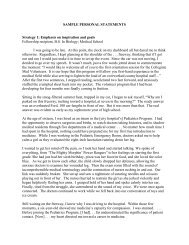Home Economics: - Phi Kappa Phi
Home Economics: - Phi Kappa Phi
Home Economics: - Phi Kappa Phi
You also want an ePaper? Increase the reach of your titles
YUMPU automatically turns print PDFs into web optimized ePapers that Google loves.
sadf<br />
By Yvonne S. Gentzler<br />
<strong>Home</strong> economics remains as relevant and complicated today as when the profession<br />
was founded in Upstate New York more than a century ago. Now, like then,<br />
people struggle with social ills such as poverty, malnutrition, and unemployment.<br />
<strong>Home</strong> economics, from its earliest incarnations to its current concerns, critiques the social<br />
scene and applies principles from the sciences, such as chemistry, economics and psychology,<br />
to improve the quality of life of individuals, advance the welfare of communities,<br />
and, ultimately, ensure social justice for all. How do we maximize human potential?<br />
One answer lies in the ever-timely and forever-complex profession of home economics.<br />
The pursuit began as an experiment and became an institution. Accusations of obsolescence<br />
eventually set in as sensibilities changed, and the field underwent modifications out<br />
of necessity. It continues to evolve to meet contemporary exigencies. From starting point to<br />
ultimate destination, the path of home economics in the U.S. is as intricate as it is thorny.<br />
Historical necessities<br />
Late 19 th -century America faced dilemmas<br />
such as massive immigration, overcrowded<br />
cities, poor sanitation, and unregulated<br />
sweatshops. Activists,<br />
educators, researchers, and others<br />
who sought social reform vis-àvis<br />
poverty reduction, residential<br />
inefficiencies, union representation,<br />
and women’s suffrage, and<br />
who believed that scientific theories<br />
could be applied to habitation, convened<br />
at a September 1899 conference in<br />
Lake Placid, N.Y., to ameliorate “living<br />
conditions in the home, the institutional<br />
household, and the community.” 1<br />
Participants sewed seeds that had been<br />
planted for generations. Aspects of what<br />
would become home economics date at<br />
least to the late 1700s through the sweeping<br />
ingenuity of the American-born British<br />
loyalist Count Rumford (Sir Benjamin<br />
Thompson), a physicist and inventor. As an<br />
adviser to Bavaria, he organized industrial<br />
schools for soldiers’ children, built workhouses<br />
for the poor, made beggars self-sufficient,<br />
and concocted the inexpensive but<br />
nutritious Rumford’s soup of barley, peas,<br />
potatoes, and beer for the indigent and incarcerated.<br />
In England, Rumford improved<br />
heating apparatuses that warmed homes<br />
and cooked food, and his Rumford fireplace<br />
was influential. He came up with the<br />
drip coffee pot and utilized science to<br />
prepare food and study nutrition. Rumford<br />
also devised a folding bed. 2<br />
Other precursors of home economics:<br />
Formal instruction in needlework for girls<br />
outside the home began in New England in<br />
1789 as a way to teach the alphabet and<br />
numbers. 3 Educator Catharine Beecher published<br />
A Treatise on Domestic Economy in<br />
1841. Eastern cities like Boston and <strong>Phi</strong>ladelphia<br />
opened cooking schools by the<br />
1860s, and in 1873 Kansas State Agricultural<br />
College offered curriculum in domestic<br />
economy. The Kitchen Garden Movement,<br />
vocational training for working-class<br />
girls, was started by welfare worker Emily<br />
Huntington in 1875. The Centennial Exposition<br />
in <strong>Phi</strong>ladelphia in 1876 encouraged<br />
study of the home in public schools (shop<br />
For more about Ellen<br />
Swallow Richards,<br />
see page 8.<br />
Undergraduates at an unidentified school learn culinary arts in 1926.<br />
Library of Congress<br />
work for boys; domestic sciences for girls).<br />
And by 1880, domestic science had been<br />
introduced in public elementary and secondary<br />
schools in Boston.<br />
The Lake Placid conference in<br />
1899 unified various humane<br />
agendas. Among the attendees<br />
was Ellen Swallow Richards, the<br />
first female graduate (in sanitary<br />
engineering and public health)<br />
from Massachusetts Institute of<br />
Technology and the driving force behind<br />
the New England Kitchen for Boston poor<br />
in 1890 and the related Rumford Kitchen<br />
that was unveiled at the 1893 Chicago<br />
World’s Fair and was inspired by Count<br />
Rumford’s breakthroughs in the science of<br />
cooking and nutrition. Also at the Lake<br />
Placid conference were Melvil Dewey,<br />
creator of the Dewey Decimal System, and<br />
his first wife Annie, who helped him establish<br />
the Lake Placid Club for social, cultural<br />
and spiritual enrichment; and Wilbur O.<br />
Atwater, the first director of the United<br />
States Agricultural Experiment Station and<br />
a pioneer in human nutrition research.<br />
Experts in everything from biology to<br />
physics, theology to philosophy, and art to<br />
literature also weighed in at subsequent<br />
yearly meetings that lasted for a decade.<br />
The forward-thinking group created an<br />
interdisciplinary body of knowledge that<br />
marked the beginning of a groundbreaking<br />
profession called home economics. 4 The<br />
purpose of the conference was to work<br />
with governmental agencies, educational<br />
bodies, and philanthropic entities; the<br />
American <strong>Home</strong> <strong>Economics</strong> Association<br />
would be created in 1909. Attendees<br />
decreed that home economics deserved its<br />
own course of study at colleges and universities<br />
and should not be confused with<br />
the “household arts” (physics and chemistry<br />
applied to food preparation and house<br />
sanitation) which, though important in<br />
their own right, were already part of school<br />
curriculum. Discussions took place about<br />
helping women in city tenements and training<br />
cooks and waitresses. Attendees agreed<br />
that the time had come for “recognition by<br />
the state of the important sociologic<br />
problem of the home. Therefore states<br />
Summer 2012 5






